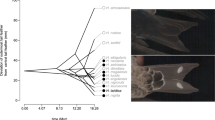Abstract
Alternative phenotypes in natural populations can arise from either genetic polymorphism or an environmentally induced phenotype, that is, polyphenism. Evolutionary models of polyphenism developed by theoretical studies predict that polyphenism is favored when there are environment-dependent fitness trade-offs between alternatives and that the threshold frequency for a facultative switch between alternative phenotypes is adjusted in accordance with different selection regimes. The broad-headed (alternative) larval morph of Hynobius retardatus, which is induced by crowding with conspecifics or heterospecific anuran (Rana pirica) larvae, is a representative example of cannibalistic polyphenism. Morph induction by such proximate factors must reflect evolutionary (conditional frequency-dependent) processes. To clarify the role of frequency-dependent processes in polyphenism, I investigated the occurrence rate of the broad-headed morph under experimental crowding conditions (low conspecific, high conspecific, and high heterospecific densities) using larvae from eight natural populations with different larval densities of conspecifics and heterospecifics, and found interpopulational differences in the expression of the morph. Thus, there is a larval density-dependent equilibrium frequency of the morph in each pond, suggesting that the local switch point for morph induction was modified by selection to produce evolved differences between ponds. The evolution of such interpond differences has three necessary conditions: (1) There are pond-dependent fitness trade-offs between alternatives, (2) The maintenance of the morph is costly, and (3) The presence of conspecific or, especially, heterospecific larvae provides a reliable cue to the receiver.



Similar content being viewed by others
References
Altwegg R, Reyer HU (2003) Patterns of natural selection on size at metamorphosis in water frogs. Evolution 57:872–882
Collins JP, Cheek JE (1983) Effect of food and density on development of typical and cannibalistic salamander larvae in Ambystoma tigrinum nebulosum. Am Zool 23:77–84
Dahl J, Peckarsky BL (2002) Induced morphological defenses in the wild: predator effects on a mayfly, Drunella coloradensis. Ecology 83:1620–1634
Elgar MA, Crespi BJ (1992) Cannibalism: ecology and evolution among diverse taxa. Oxford Univ. Press, Oxford
Goater CP (1994) Growth and survival of postmetamorphic toads: interactions among larval history, density, and parasitism. Ecology 75:2264–2274
Hazel W, Smock R, Lively CM (2004) The ecological genetics of conditional strategies. Am Nat 163:888–900
Hjelm J, Svanback R, Bystrom P, Persson L, Wahlstrom E (2001) Diet-dependent body morphology and ontogenetic reaction norms in Eurasian perch. Oikos 95:311–323
Hoffman EA, Pfennig DW (1999) Proximate causes of cannibalistic polyphenism in larval tiger salamanders. Ecology 80:1076–1080
Laurila A, Karttunen S, Merila J (2002) Adaptive phenotypic plasticity and genetics of larval life histories in two Rana temporaria populations. Evolution 56:617–627
Leips J, McManus MG, Travis J (2000) Response of treefrog larvae to drying ponds: comparing temporary and permanent pond breeders. Ecology 81:2997–3008
Lively CM (1986) Canalization versus developmental conversion in a spatially variable environment. Am Nat 128:561–572
Lively CM (1999) Developmental strategies in spatially variable environments: barnacle shell dimorphism and strategic models of selection. In: Tollrian R, Harvell CD (eds) The ecology and evolution of inducible defenses. Princeton Univ. Press, Princeton, pp 245–258
Loeb ML, Collins GJP, Maret TJ (1994) The role of prey in controlling expression of a trophic polyphenism in Ambystoma tigrinum nebulosum. Funct Ecol 8:151–158
Maynard Smith J (1998) Evolutionary genetics, 2nd edn. Oxford Univ. Press, Oxford
Michimae H, Wakahara M (2001) Factors which affect the occurrence of cannibalism and the broad-headed “cannibal” morph in larvae of the salamander Hynobius retardatus. Behav Ecol Sociobiol 50:339–345
Michimae H, Wakahara M (2002) A tadpole-induced polyphenism in the salamander Hynobius retardatus. Evolution 56:2029–2038
Michimae H, Nishimura K, Wakahara M (2005) Mechanical vibration from tadpole’s flapping tails transform salamander’s carnivores morphology. Biol Lett 1:75–77
Moran NA (1992) The evolutionary maintenance of alternative phenotypes. Am Nat 139:971–989
Nishihara A (1996) Effects of density on growth of head size in larvae of the salamander Hynobius retardatus. Copeia 1996:478–483
Ohdachi S (1994) Growth, metamorphosis, and gape-limited cannibalism and predation on tadpoles in larvae of salamanders, Hynobius retardatus. Zool Sci 11:127–131
Pfennig DW (1992) Polyphenism in spadefoot toad tadpoles as a locally adjusted evolutionary stable strategy. Evolution 46:1408–1420
Pfennig DW (2000) Effect of predator-prey phylogenetic similarity on the fitness consequences of predation: a trade-off between nutrition and disease? Am Nat 155:335–345
Scott DE (1994) The effect of larval density on adult demographic traits in Ambystoma opacum. Ecology 75:1383–1396
Trussell GC, Nicklin MO (2002) Cue sensitivity, inducible defense, and trade-offs in a marine snail. Ecology 83:1635–1647
Walls SC, Roudebush RD (1991) Reduced aggression toward siblings as evidence of kin recognition in cannibalistic salamanders. Am Nat 138:1027–1038
West-Eberhard MJ (2003) Developmental plasticity and evolution. Oxford Univ. Press, Oxford
Whiteman HH, Sheen JP, Johnson EB, VanDeusen A, Gargille R, Sacco TW (2003) Heterospecific prey and trophic polyphenism in larval tiger salamanders. Copeia 2003:56–67
Acknowledgements
I thank Masami Wakahara, Kinya Nishimura, two anonymous reviewers, and the associate editor for their comments on the manuscript. This work was supported by a Grant-in-Aid for Scientific Research (No. 15009850) from the Japan Society for the Promotion of Science. All experiments were performed in agreement with the laws of Japan.
Author information
Authors and Affiliations
Corresponding author
Additional information
Communicated by J. Christensen-Dalsgaard
Rights and permissions
About this article
Cite this article
Michimae, H. Differentiated phenotypic plasticity in larvae of the cannibalistic salamander Hynobius retardatus . Behav Ecol Sociobiol 60, 205–211 (2006). https://doi.org/10.1007/s00265-005-0157-x
Received:
Revised:
Accepted:
Published:
Issue Date:
DOI: https://doi.org/10.1007/s00265-005-0157-x




